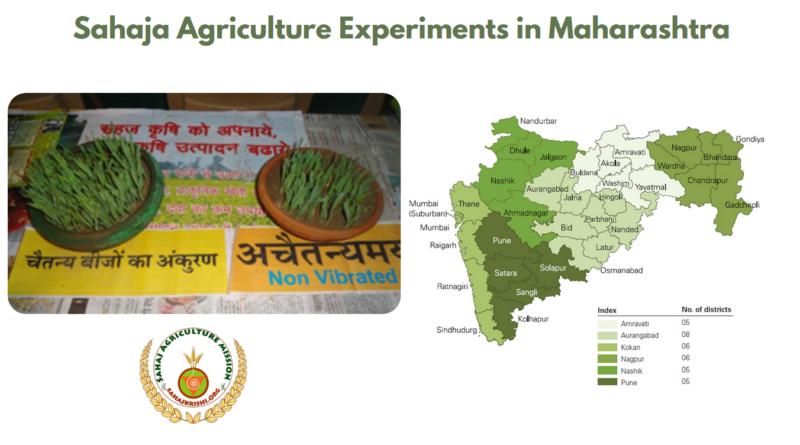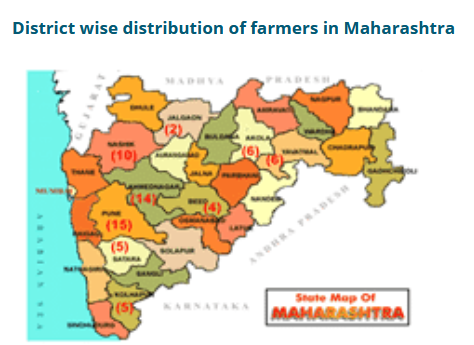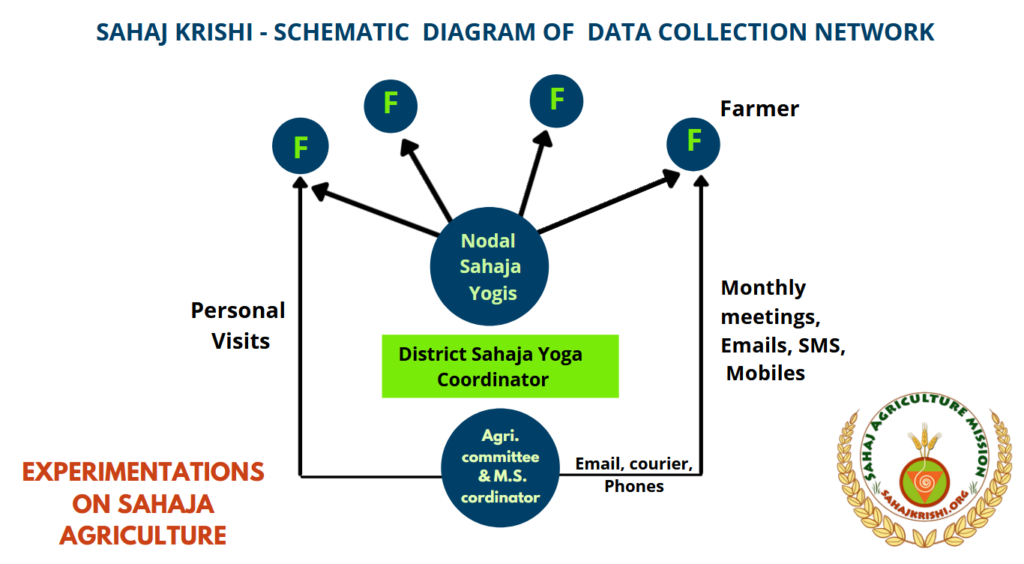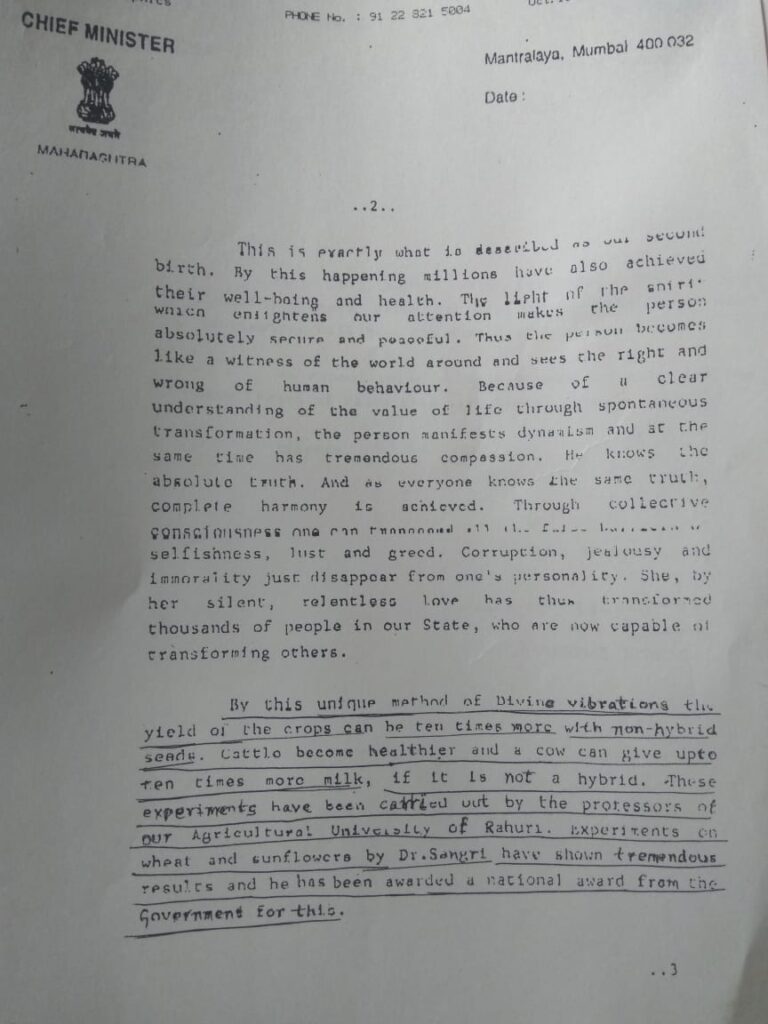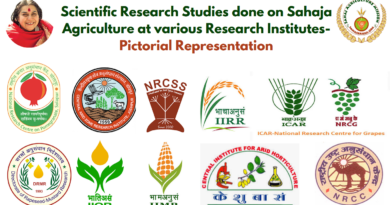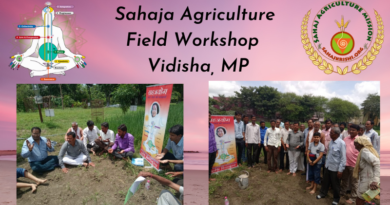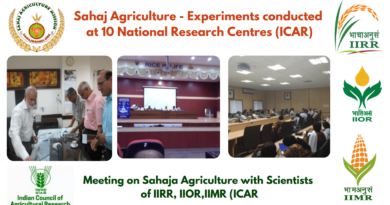Sahaja Agriculture Experiments in Maharashtra
Sahaja Agriculture Experiments in Maharashtra
Shree Mataji visited Rahuri Agricultural University in 1984-85 and shared her experience of improving the size and yield of sunflower at Pune through using vibrations of Sahaja Yoga. Shree Mataji suggested scientists to use Sahaja Yoga meditation techniques to start experiments on agriculture and animal husbandry and place the results before the government and farming community of the country. Since then, some scientists and farmers experimented on the effect of vibrations on various agricultural crops.
However, first large scale experiment using Sahaja Yoga techniques on agriculture was set up by a Sahaja Agricultural Committee formed in Maharashtra in 2010. To start Sahaja Krishi programme in the country, Maharashtra Sahaja Krishi Samiti constituted at MPKV, VC Camp Office, Pune, on 28th Dec 2011 as below:
Table . Constitution of Agricultural Sub-Committee, Maharashtra, 2010
| Name | Department | Committee |
| Dr. M. B. Kulkarni | Retired HOD, MPKV, Rahuri | Coordinator |
| Mr. B. D. Kumbhojkar | Retired Prof, MPKV, Rahuri | Member |
| Dr. Mangesh Deshmukh | Asso. Prof (Hort), Agriculture College, Pune | Member |
| Mr. Bhaskar Thorat | B.Sc. (Agri), Adviser – Horticultural Services, Pune | Member |
| Dr. Raj Purohit | Dy. Director (Agriculture), Gujarath | Member |
| Mr. Ramdas Jadhav | Progressive Farmer, Nashik | Member |
Methodology
The whole experiments were conducted in the state of Maharashtra as below.
Fig. Scheme of data collection and data collection from farmers in Maharashtra.
- Field experiments were done on Kharif crops which are domesticated plants cultivated and harvested during the rainy or monsoon season
- Systematic data was collected from 66 farmers who reported their observations from time to time
- Comparison was made of 2 lots/groups, namely vibrated (E) and non- vibrated (C); data was compiled , tabulated and compared for the following observations:
- Germination of seeds
- Plant growth
- Crop product characteristics
- Yield of crops
Layout of Experiments: Experiments were divided into 3 categories:
- Agricultural
- Horticultural
- Animal Science
- Scientific methodology for all experiments
- Observation charts formulated
- Precautions in experiments spelled out
- Booklet on guidelines in marathi prepared
- Selection of nodal Sahaj Yogies
- Training to nodal Sahaj Yogies
- Farmer’s awareness camps
- Selection of farmers
- Replying farmer’s queries
- Detailed instructions to farmers
- Commencement – Kharip 2011
Findings of experimentations on Sahaja Agriculture
Table. Crops/Animals/Birds for experiments
| Sr.No. | Crop | Variety/Breed |
| Soya bean | GS 385, Mahabeej, 9305, JS 335 | |
| Sugarcane | C0265 | |
| Cotton | BT (Ganesh) (Dhruv) | |
| Jowar | Hybrid | |
| Maize | Dhanya 8255, CP828, DK984 | |
| Bajara | No. 163 | |
| Onion | Prashant Red | |
| Chavali | Local | |
| 9 | Geese / Turkey (Immu) | Australian |
Results
Rahuri Agriculture University in Maharashtra has been in forefront of doing research on sahaja Agriculture since long. The germination rate increased in vibrated plants by 12.2% in soyabean, 20% in cotton, 16.6% in maize and 20% in Sorghum as compared to their respective control trials under lab conditions, although there was improvement in case of Bajra and Onion.
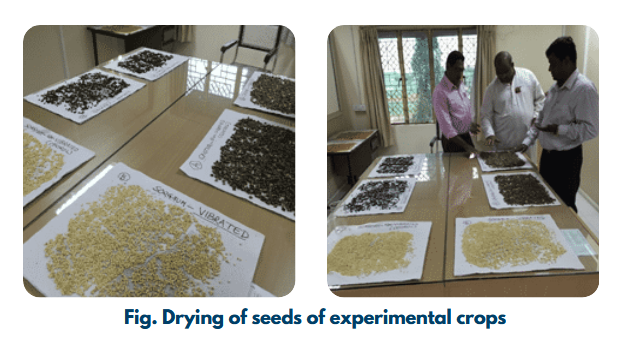
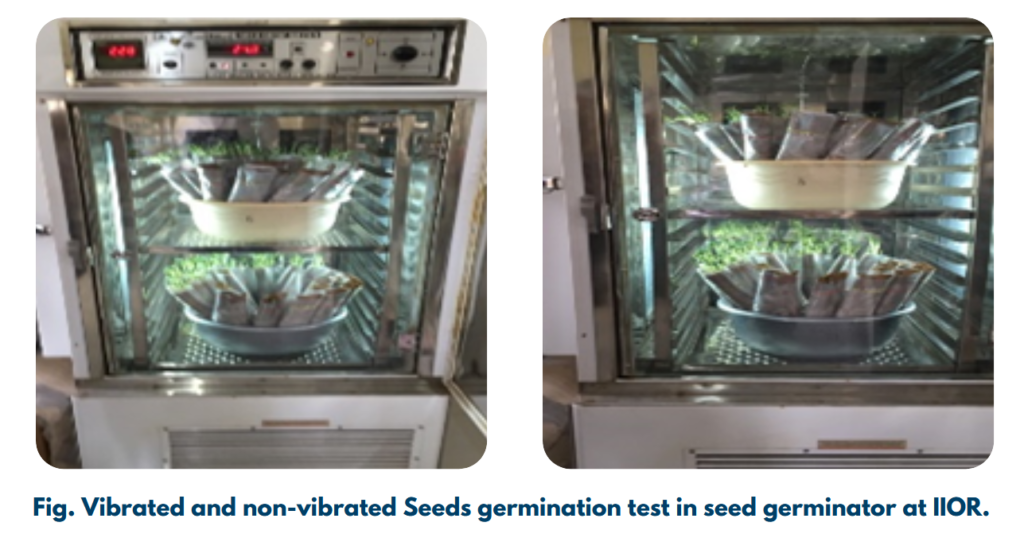
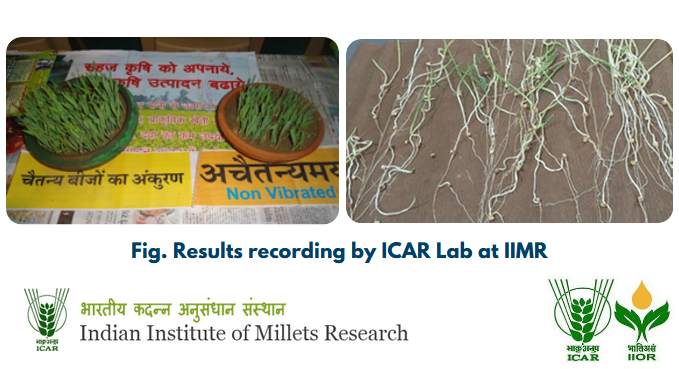
There was an increase in height of various crops, 33.3% in Soya bean, 18% in Cotton, 20% in Maize, 7.7% in Bajra and no improvement in Onion, as compared to their respective control trials. In Sugarcane, the increase was 34.2% in number of nodes after 6 months (Ratoon) and 42.9% increase in average node girth (cm) as compared to non-vibrated control.
There was tremendous improvement of economic characteristics of various crops. In cotton, boll weight increased by 42% (from 3.5 to 5 g), in vibrated Bajra, ear head size increased by 6.5%, weight of 100 grains increased by 39.2% as compared to non-vibrated plants. In vibrated maize, the cob size increased by 7.6% (from 15.4 to 16.6) and weight of 100g increased by 29.1% as compared to control. In vibrated chavali, pod size increased by 25%, (from 16 cm to 20 cm) and weight of 100g increased by 80%, as compared to non-vibrated plants.
Table. Effect of vibrations on the growth of crops, Maharashtra.
| Crop | No | Parameter | Experimental E (Vibrated) | Control C (Non Vibrated) | % increase over Control |
| Soya bean | 70 | Height (cm) | 57.5 | 43.2 | 33.3 |
| Sugar Cane | 20 | No of nodes after 6 mths (Ratoon) | 23.5 | 17.5 | 34.2 |
| Av. Node girth (cm) | 5 | 3.5 | 42.9 | ||
| Cotton | 60 | Height (cm) | 32.8 | 27.9 | 18 |
| Maize | 70 | Height (cm) | 180 | 150 | 20 |
| Bajara | 10 | Height (cm) | 84 | 78 | 7.7 |
| Onion | 10 | Height | 7.5 | 7.5 |
Table. Effect of vibration on the yields of crops
| Crop | No | Yield / acre Experimental E (Vibrated) | Yield / acre Control C (Non Vibrated) | % increase over Control |
| Soya bean | 70 | 9.71 | 7.82 | 24.2 |
| (Quintal) | ||||
| Cotton (Q) | 60 | 11.1 | 8.0 | 37.8 |
| (in 2 pickings) | ||||
| Maize (Q) | 70 | 26 | 20 | 30 |
| Hy. Sorghum (Q) | 20 | 15 | 10 | 50 |
| Bajara (Q) | 10 | 16 | 14 | 14.3 |
| Onion | 10 | 15 | 11 | 36 |
There was tremendous improvement in the yields of vibrated crops as compared to non-vibrated control. In vibrated soybean the yield increased (24.2%) to 9.7 quintals/acre from 7.8 quantals in non-vibrated. In vibrated cotton, the yield increased (37.8%) to 11.1 quintals/acre from 8.0 quantals in non-vibrated. In vibrated maize, the yield increased (30%) to 26 quintals/acre from 20 quantals in non-vibrated. In vibrated maize, the yield increased (30%) to 26 quintals/acre from 20 quantals in non-vibrated control. In vibrated Hy. Sorghum, the yield increased (50%) to 15 quintals/acre from 10 quantals in non-vibrated control. In vibrated Hy. Sorghum, the yield increased (50%) to 15 quintals/acre from 10 quantals in non-vibrated control. In vibrated Bajara (Q), the yield increased (14.3%) to 16 quintals/acre from 14 quantals in non-vibrated control. In vibrated onion, the yield increased (36%) to 15 quintals/acre from 11quantals in non-vibrated control.
In other trials, the onion yield increased to 4 quintals/ acre in vibrated crop as compared to 2 quintals/ acre in non-vibrated crop (Fig).

The yield increased in soybeans to 12 quintals/ acre in vibrated crop as compared to 7 quintals/ acre in non-vibrated crop (Fig.).
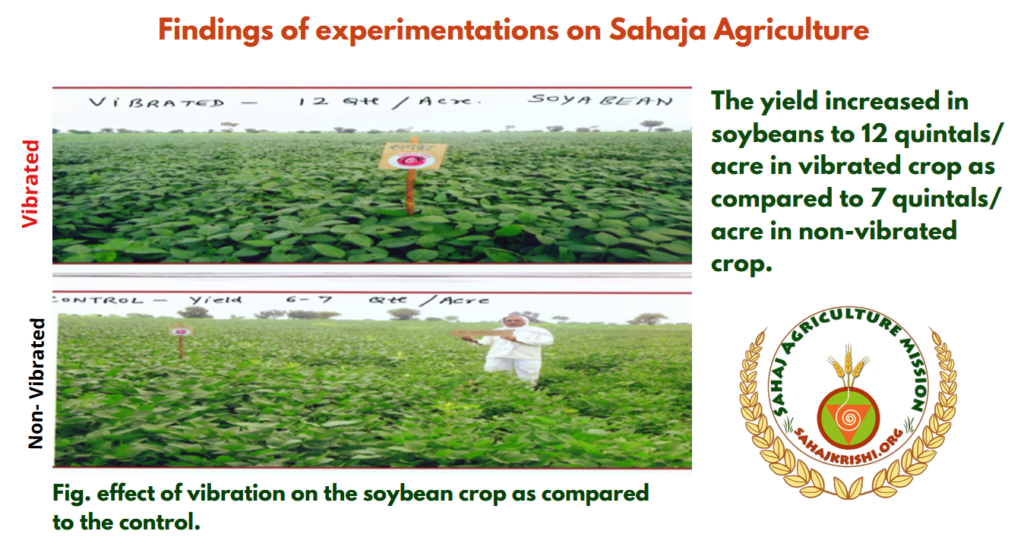
The crop yield in cotton crop increased to 14 quintals/ acre in vibrated crop as compared to 10 quintals/ acre in non-vibrated crop (Fig.).
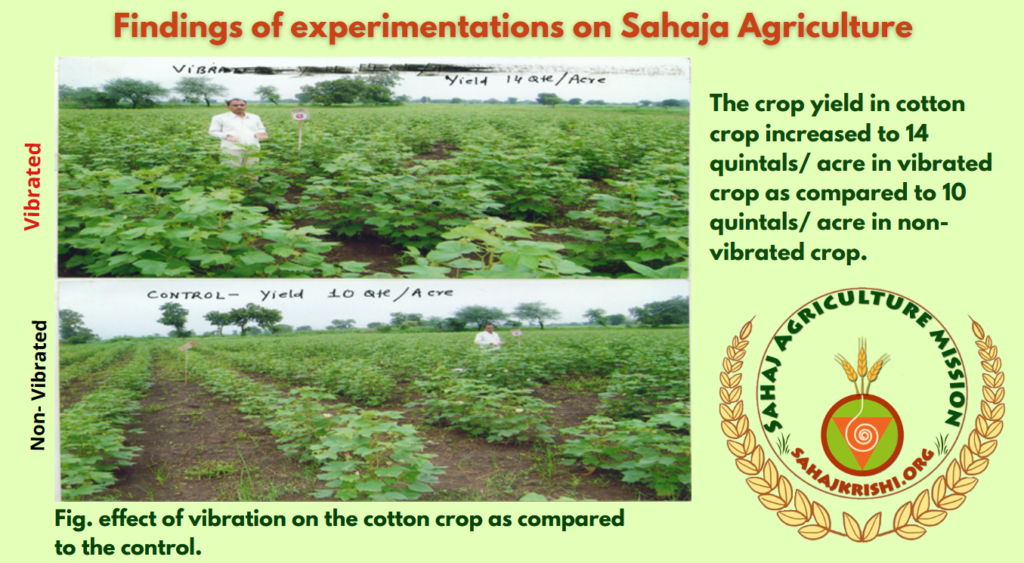
The crop yield in gram crop increased to 10 quintals/ acre in vibrated crop as compared to 7 quintals/ acre in non-vibrated crop (Fig.).
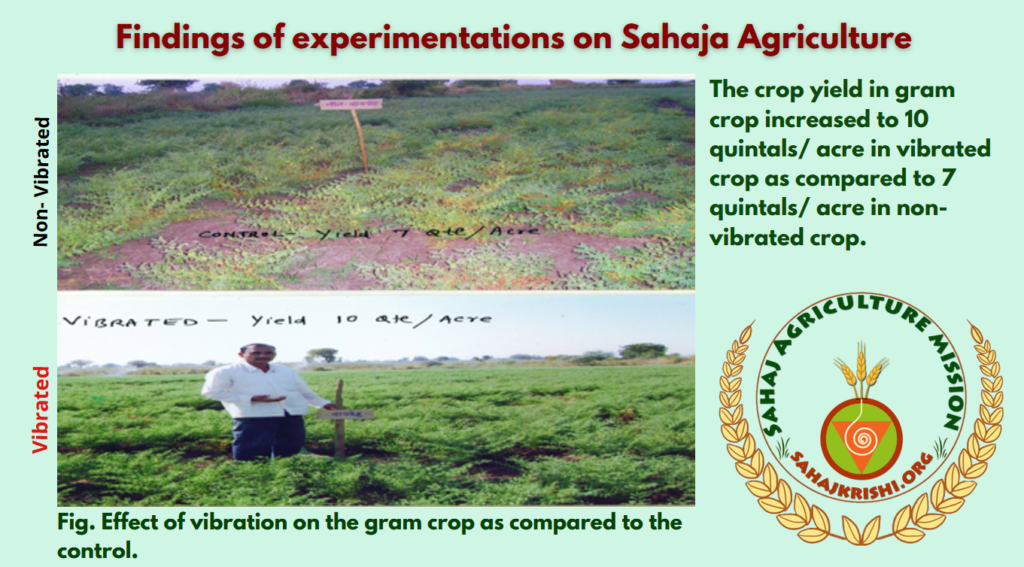
Overall findings of experiments on agricultural crops
- Out of 66 farmers, none of the cases showed negative results due to vibrations
- Mean increased growth in plants in different crops ranged from 0 – 42.9% due to vibrations
- Increase in germination % due to vibrations was from 0 to 20
- Different product characters due to vibrations improved by 4 to 80%
- Yield of crops due to vibrations increased from 14.3% to 50%
Effect of vibrated feed on growth of Turkey birds (Imu)
Experiments were conducted on the effect of sahajayoga meditation vibrations on the growth of body weight of turkey, used for the egg production. The body weight taken twice improved in turkey birds 80-100% higher the control (Table ).
| Animal/Bird | No | Breed | Age | Initial Body weight (Kg) | Final Body weight (Kg) | % increase over initial weight | |||
| E | C | E | C | E | C | ||||
| Turkey (Immu) | 48 | Australian | 3 mths | 2.25 | 2 | 4 | 4 | 77.7 | 100 |
| Turkey (Immu) | 58 | Australian | 20 mths | 20.5 | 20.5 | 41.5 | 36.5 | 105 | 80 |

